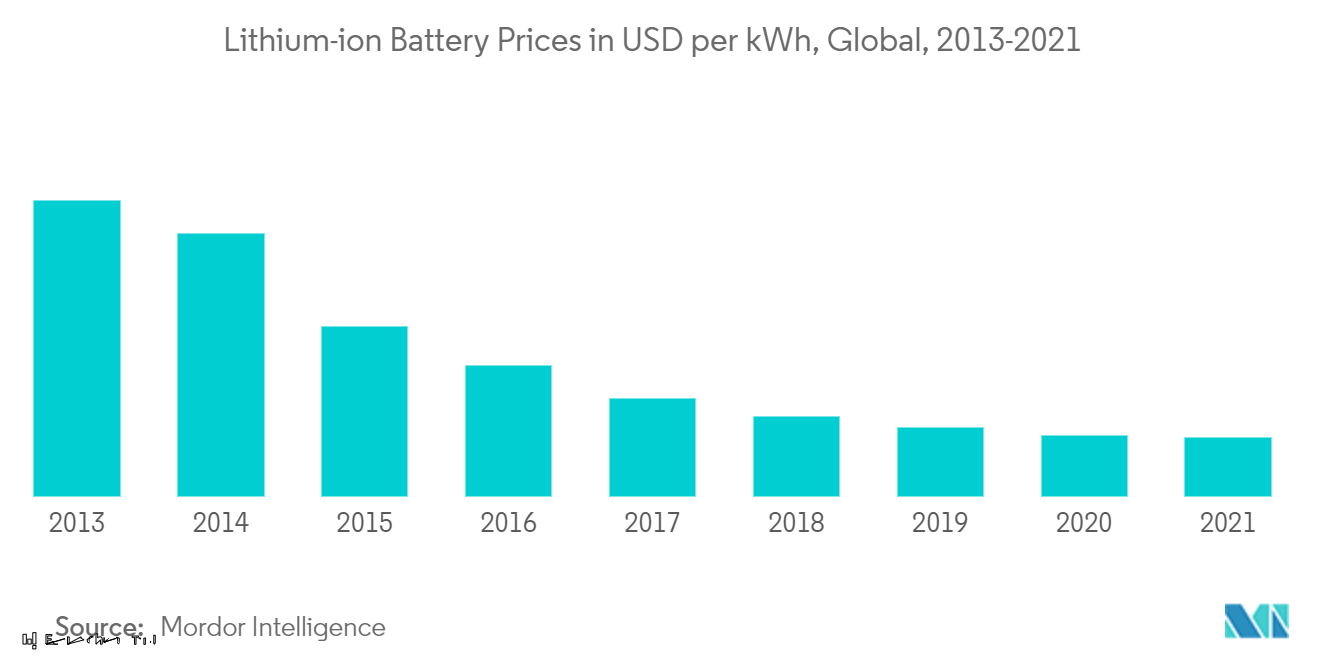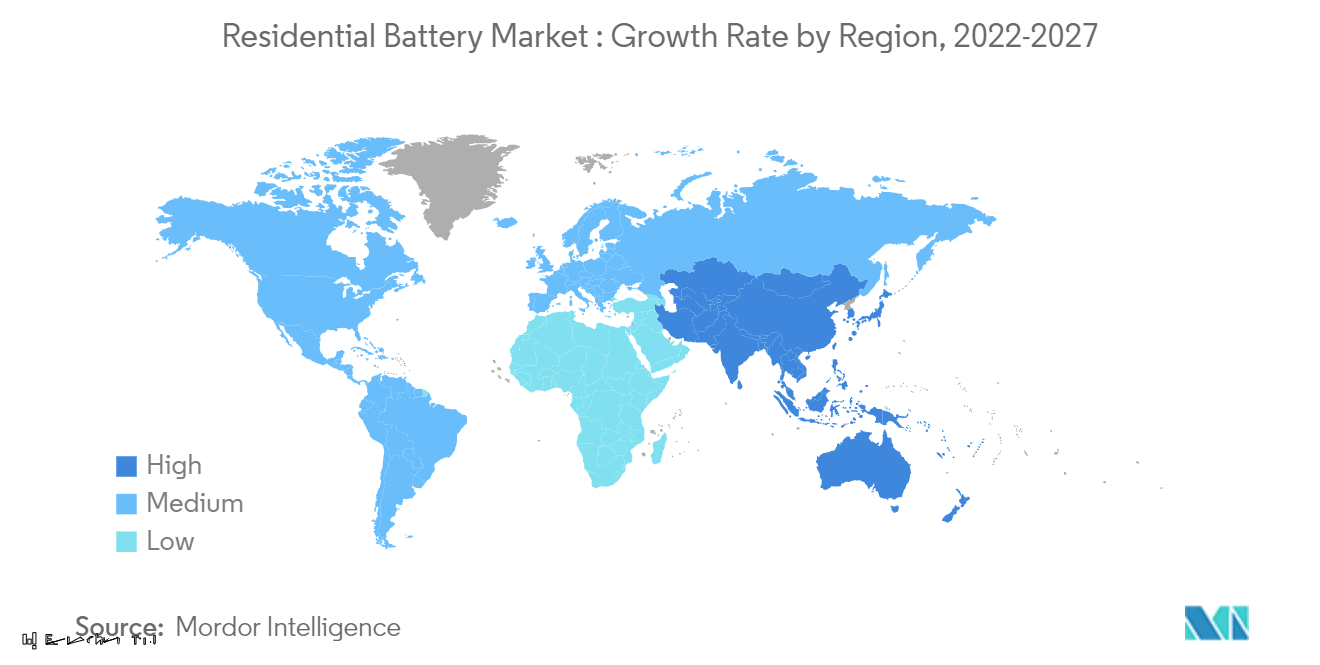Market Trends of Residential Energy Storage Systems Industry
This section covers the major market trends shaping the Residential Energy Storage Systems Market according to our research experts:
Lithium-Ion Battery Technology to Dominate the Market
- Lithium-ion (Li-ion) batteries are nearly 100% efficient in charge and discharge, allowing the same ampere-hours in and out. These batteries offer various technical advantages over other technologies, such as lead-acid batteries. Rechargeable Li-ion batteries, on an average, offer cycles more than 5,000 times, in comparison to lead-acid batteries that last for around 400-500 times.
- Li-ion batteries can be recharged numerous times and are more stable. Further, they tend to have a higher energy density, voltage capacity, and lower self-discharge rate than other rechargeable batteries. This improves power efficiency as a single cell has longer charge retention than different battery types.
- Additionally, Li-ion batteries do not need as frequent maintenance and replacement as the lead acid batteries. Li-ion batteries maintain their voltage throughout the discharge cycle, allowing greater and longer-lasting efficiency of electrical components, whereas the voltage of lead-acid batteries drops consistently throughout the discharge cycle. Despite the higher upfront cost of Li-ion batteries, the true cost is much lesser than that of lead-acid batteries, when considering lifespan and performance.
- Batteries play a crucial part in the energy storage systems and are responsible for major portion of the total cost of system, especially used in residential energy storage systems. The total installed capacity of the renewable energy sources is increasing at a significant rate, worldwide, and so is the installation of solar rooftops on the residential buildings.
- The increase in solar rooftop capacity is likely to foster the increase in the demand for battery energy storage as well. Therefore, the emergence of new energy storage systems (ESS), for residential applications, is expected to boost the demand for lithium-ion battery during the forecast period. Properties of lithium-ion batteries, such as less weight, low charging time, higher number charging cycles, and declining cost, make it preferable for this application.
- In recent times, owing to their declining prices, the lithium-ion batteries gained popularity as battery storage systems of choice for residential solar and home inverters. In 2021, the price of the lithium-ion battery was USD 123/kWh, which declined by 81.58% from USD 668/KWh in 2013.
- The residential energy storage policies till date are quite nascent. However, countries, such as the United States and Germany, through state policy action and regulatory action, are creating opportunities in the local energy storage markets.
- For instance, in June 2021, the United States Department of Energy (D.O.E) announced immediate policy to scale up domestic manufacturing supply chain for advanced battery materials and technologies.
- Therefore, based on the factors mentioned above, lithium-ion battery technology is expected to dominate the global residential energy storage systems market during the forecast period.

Europe to Dominate the Market
- Europe dominated the RESS market in 2021, and it is expected to continue its dominance in the coming years. The demand for RESS in the region is witnessing high growth due to the rapid adoption of rooftop solar power.
- The residential energy storage systems market has grown rapidly in Germany since 2015, supported by an incentive scheme granting a 30% investment subsidy for the battery system.
- Transformation in Germany's energy mix has been taking place for the past few years. Rooftop solar accounted for a significant share of Germany's total solar energy generation, mainly due to advanced supporting mechanisms introduced in the past, such as grants and loans for roof programs. In 2021, Germany introduced a reform of Renewable Energy Law or EEG 2021, which incorporates the exemption of EEG levy for the owners of PV systems for self-consumption not exceeding 30kW in size. Under the previous rules, this limit was set at 10 kW. This EEG levy is likely to boost the German residential battery market as most residential systems are in the aforementioned range.
- Further, in March 2022, the Institute for Power Electronics and Electrical Drives (ISEA) and RWTH Aachen University found that the home storage systems (HSS) accounted for 93% of the 1,357 MWh of new energy capacity installed in 2021, while the rest 7% includes industrial and large-scale storage segments.
- As of January 2022, the United Kingdom registered 13.79 GW installed solar capacity, and 26% (3.25 GW) of the total capacity has come from solar PV installations below 10 kW, mainly consisting of residential rooftop solar photovoltaic consumers.
- In the United Kingdom, an average resident consumes between 3kWh and 6kWh of energy daily; accordingly, system sizes may vary. One of the most common system capacities installed is a 4-kW system, which is suited to satisfy the energy needs of three-four people. However, a 5kW solar PV system is typical for a home with four-five people, while a 6kW solar panel system is suggested for a home with over five residents. Hence, most residential PV systems have a capacity below 10 kW in the country.
- Moreover, Italy introduced a new super bonus incentive scheme, which gives the possibility of obtaining a tax credit of 110% for the expense from July 2020 until 2023, encouraging energy efficiency interventions. However, to benefit from the super bonus, the PV and the storage system must be installed in conjunction with one of the main interventions. The overall investments made must lead to an improvement of an energy efficiency rating. In case of ineligibility, obtaining the 10-year 50% tax credit already in place for small-scale PV generation assets and BESS is possible.
- The RESS market in the region is also driven by the import of low-cost solar panels from China, helping make photovoltaic technology more competitive.
- Therefore, based on the aforementioned factors, Europe is expected to dominate the global residential energy storage systems market during the forecast period.


